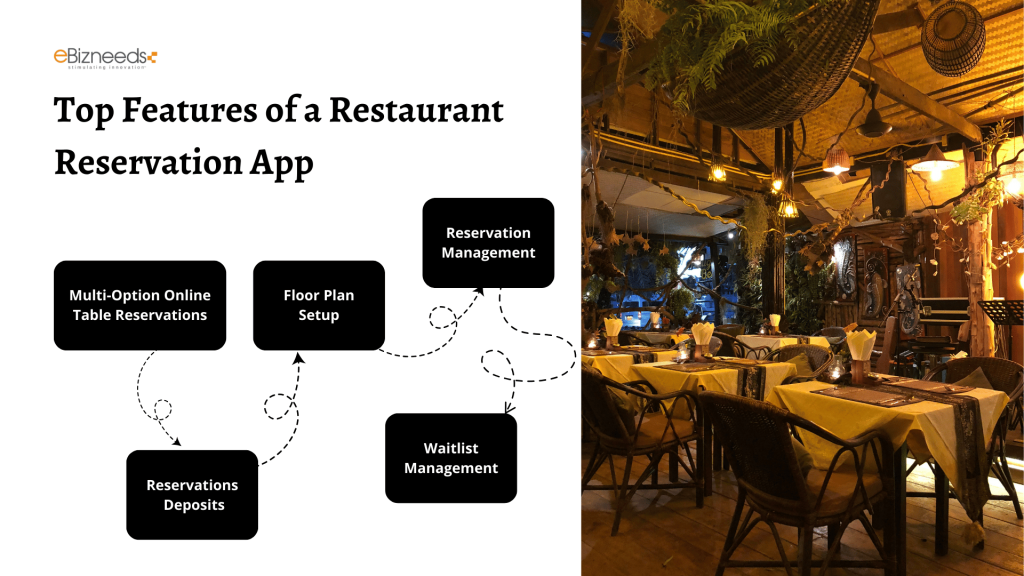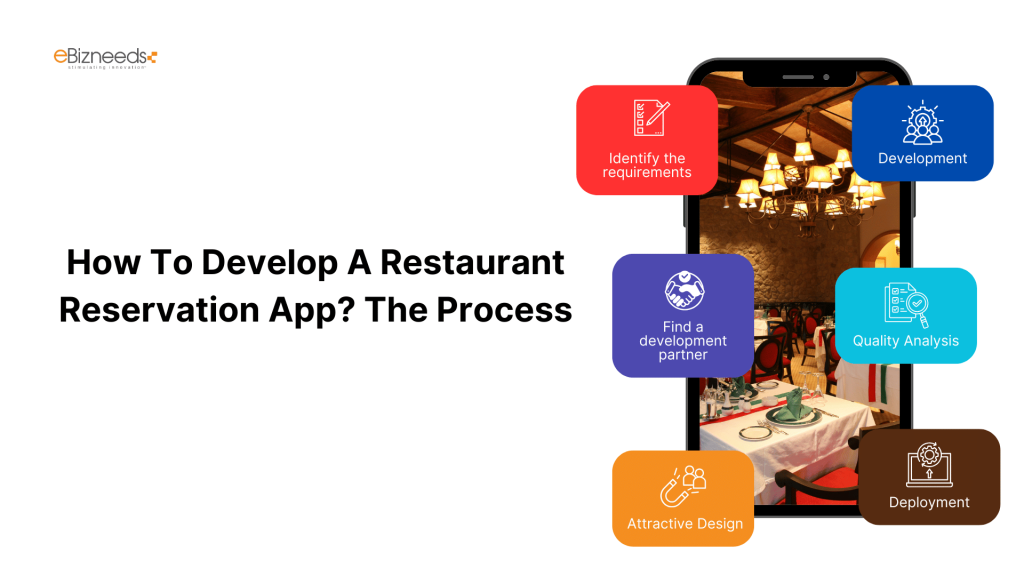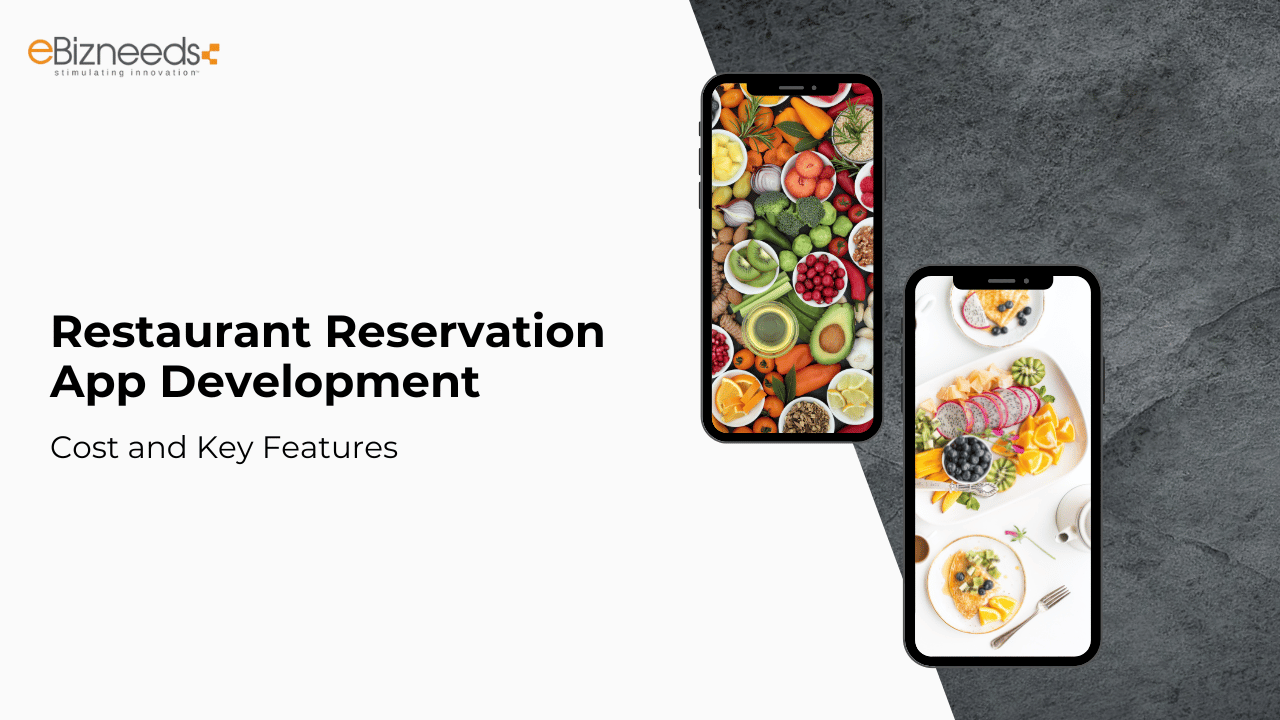Last updated on November 26th, 2024 at 12:45 pm
With technological innovation, we have seen the rise of food delivery apps that allow users to make food orders from the comfort of sitting in their homes and get it delivered to their doorsteps. The technology doesn’t end there; it also allows restaurants to deliver better service when customers visit for dine-in. The restaurant reservation app development acts as a great platform for better customer service.
The ultimate aim can be easily guessed: allowing users to book a table at the restaurant. However, the features and use cases are not just limited there. The restaurant booking app development lets you showcase your services to customers in a better and more streamlined way. Thus, if you are looking to hire mobile app developers for restaurant booking app development, you have landed on the right article.
In this article, we will cover various aspects of a restaurant booking app and provide you with a step-by-step guide on how to make a restaurant booking application. Let’s begin with the basics.
What is a Restaurant Reservation App?
A restaurant reservation app is a digital app that streamlines the reservation process of guests and restaurants. Using this app, customers can book a table online using any device for any available date in the calendar.
At the restaurant’s end, they get clear insights into upcoming bookings, cancellations, and no-shows. With these insights, they can efficiently manage their services and resources.
How does a Restaurant Booking App Development work?
In the traditional methods, the restaurants were dependent on phone calls and pen-and-paper records to book guests for tables at a given time. It requires both time and effort and is also prone to human error. There was always a possibility that the same table may get booked for two different guests for the same time slot. A digital restaurant booking app solution solves this problem by effortlessly making reservations and securing their desired dining slots.
Also, managing reservations during peak and limited working hours raises huge challenges in traditional methods. Moreover, it also occurred that some reservations were lost, not confirmed, or scribbled into a book.
However, the restaurant reservation apps work 24/7 and streamline the reservation process.
Why develop a restaurant table booking app? Market Statistics
There are many statistics that show that a lot of people are now turning to digital solutions for almost everything, and booking a table in a restaurant is a basic expectation of these solutions.
As per a survey by Ask Your Target Market, 47% of restaurant consumers say that making reservations online is easier than other methods. Furthermore, 34% mention they’re more likely to choose restaurants that offer online reservations.
These findings are a strong proponent of why it is important for restaurants to build digital solutions for table booking facilities.
Benefits of Restaurant Reservation App Development:



There are numerous benefits of restaurant reservation app development for both customers and restaurants. Since the use case is different for both parties, the benefits would also be different. Here are the major benefits:
For Customers:
a. Avoid Long Queues:
The foremost benefit of restaurant reservation app development for customers is that after reservation, they aren’t required to stand in long queues. Using the app, customers can easily select the time slot of the meal, book a table, enter the number of expected guests, and even pre-order their food. The restaurants also get insights into the estimated number of customers for the day to manage staff and food accordingly. There will be less food wastage as well.
b. Check Menu:
The restaurant owners can provide the menu on the digital app, which they can use to mention available items along with their prices. Thus, the customers will be aware of what is available during that slot and order accordingly.
c. Read Reviews and Feedback:
Customers can check reviews and feedback from other visitors, which gives them insight into hygiene, food quality, serving manners, and more, helping them make quick decisions.
d. Avoid the hassle of calling:
Customers are not required to follow the traditional process of calling. They don’t need to call a restaurant to book a table, know the menu, and give special instructions if required. Using restaurant table booking apps, they can perform all these tasks independently without any interruption.
For Restaurant Owners:
a. Maximizing Table Reservations:
With the restaurant booking software, there will be a marginal difference in your restaurant’s table reservations. This is because of two major reasons. First, the diners wouldn’t be restrained by the working hours of the restaurants when making orders. Secondly, there will be more than one option of how to make a reservation.
There are many statistics showing that allowing customers to make reservations after working hours is important for customers’ success. Nearly 40% of people prefer scheduling appointments outside regular working hours.
b. Improves Reservation Management:
Effective reservation management is crucial for successfully running a restaurant. It provides a thorough picture of reservations, allowing you to forecast the number of expected visitors, distribute tables efficiently, and manage staff and resources accordingly.
With dependable table booking software, you can easily overcome these problems.
c. Reduces the number of “No-shows”:
If a customer makes a booking but fails to show up or inform the restaurant in advance, it becomes a significant challenge for the restaurant. This is called a “No-Show”.
Surprisingly, up to one in every seven reservations results in a no-show, which may be devastating to a business. After all, once a table is reserved, it cannot be provided to another customer.
By adopting a restaurant booking system, you may automatically send reservation reminders to customers, allowing them to remember their reservations.
Types of Restaurant Booking Apps:



By Business Model
While developing a restaurant booking app, you have to decide which business model you want to implement in the app. There are two major types of business models that are used in business logic when you want to develop a restaurant reservation app. Let’s discuss them in brief:
a. Aggregator Model:
The aggregator model works like a marketplace in which restaurants can register themselves on your app. The revenue model would be charging a fixed amount or a percentage commission for each transaction or table booked. In this model, you can connect with many restaurants and increase your business reach and ROI. It is widely used by companies like Yelp, OpenTable, and more to provide users with recommendations and services.
b. Self-Owned App:
In the self-owned model, the restaurant owners build an app for themselves to reserve tables and other functionalities. Herein, restaurants are not required to pay any aggregator a commission or fixed fee. Restaurant owners can offer special discounts, increasing app downloads and customer loyalty.
By Functioning:
After deciding on the business model, the next step is to understand what functioning of an app should you develop.
Although, as users, we feel that all apps have the same functionality, each application is discreetly designed according to the online food business model. Let’s know about the types of restaurant booking apps as per functionality:
a. Find Your Restaurant App:
The Find Your Restaurant app helps users find nearby restaurants within their vicinity based on geo parameters. It is a restaurant locator app by which users can find restaurants according to cuisine types, food items, dining areas, ordering, and popularity.
The development requires comprehensive databases of all the restaurants, cafes, and diners in different localities and neighbourhoods.
The database can be created using the Google Places API, and geolocation can be used to help users find eating establishments within their radius.
b. On-Table Order and Pay App:
This app facilitates the user experience when customers visit a restaurant. Instead of waiting for the restaurant staff, it allows them to make orders and payments while sitting at the table.
The software offers the ability to place an order from the accessible menu, which generates a check for an order that is picked up by a kitchen display system (KDS).
This order can then be completed via a payment and tip POS, which can be closed once the customer has fulfilled the function.
c. Online Ordering and Delivery App:
As the name indicates, the online ordering and delivery app provides users with the functionality of making orders while sitting at home. The customers would be able to place orders and make payments, and the food would be delivered right to their doorstep. The software allows users to find restaurants in their area, see menus, place orders, pay for selected goods, and track order delivery.
Top Features of a Restaurant Reservation App:



A feature-rich and efficient restaurant reservation app can make operations more efficient. Here are the major features that you can include in your restaurant reservation app:
a. Multi-Option Online Table Reservations:
The users should get a straightforward and modern restaurant reservation system to book a table online. To be effective, a reservation system should have a widget that can be connected to a variety of platforms, some of which are shown below. Wix, Squarespace, and GoDaddy are among the prominent website-building platforms, as are Facebook, Instagram, and Google Business.
b. Reservations Deposits:
Within the online reservation feature, there must be an option to take deposits. This is because late cancellations and missed reservations are all too common in the restaurant industry. To overcome this problem, using a reservation system that allows you to take reservation deposits is extremely important.
c. Floor Plan Setup:
The next important feature is the floor plan setup. Having such a function in your restaurant reservation application is vital for seamless operations and improved table management.
This feature should allow you to easily replicate your restaurant’s floor layout by dragging and dropping tables, assigning the number of empty chairs per table, and creating appropriate table names.
d. Reservation Management:
An effective reservation management feature includes a good review of all your reservations, along with options for quick updates and filtering. Easy reservation management will help you improve your table turnover times and increase your earnings.
e. Waitlist Management:
A good restaurant booking app must have a feature for waitlist management. A restaurant has two types of customers: reserved-table ones and walk-ins. That is why many restaurants leave a few seats open for walk-ins while making them unavailable for Internet reservations.
A waitlist management function can help staff deal with the flow of walk-in clients and arrange them at the appropriate tables.
How to Develop a Restaurant Reservation App? The Process



Here is the process that you have to follow for developing a restaurant booking app:
a. Identify the requirements:
Firstly, you have to collate the requirements and understand what features and functionalities you want to include in your restaurant reservation app. You also have to do market research to understand whether you need to develop a web app or a mobile app, an iOS app, or an Android app.
b. Find a development partner:
You must find a reliable mobile app development company that can provide you with the best development services. We recommend to hire mobile app developers from Southeast Asian countries like India, as there you will get best quality development at affordable rates. You must go through the prior work experience, skills of the development team, reviews & ratings, and client feedback of the company before hiring them.
c. Attractive Design:
The app’s UI and UX play an important role in defining its success. The design should be attractive and captivating for the users. You can take reference of your competitor’s apps for a better design. A great UI/UX will assist you in increasing ROI and customer retention rates, improving SEO ranks, promoting client loyalty, and aiding in business expansion.
d. Development:
After the design part, the next step is development. There will be frontend and backend development. The front-end developers should ensure that the app works responsively on all devices or touchpoints. The backend developers are responsible for ensuring the app’s smooth and seamless functionality.
e. Quality Analysis:
After the development, the QA experts will check the app for bugs or issues. They have to ensure that there are no persisting bugs remaining on the app. They also check for performance and security as per the scope of work.
f. Deployment:
After the sign-off from the QA team, the development team deploys the app on the production server and launches the app on the required app stores.



Wrapping Up:
In this article, we have gone through several aspects of the development of the restaurant reservation app. At Ebizneeds, the best mobile app development company, we have expertise in developing mobile applications from scratch. Our mobile app developers have vast experience developing fully-fledged mobile apps with advanced features and functionalities. Let us know your requirements.



Naveen Khanna is the CEO of eBizneeds, a company renowned for its bespoke web and mobile app development. By delivering high-end modern solutions all over the globe, Naveen takes pleasure in sharing his rich experiences and views on emerging technological trends. He has worked in many domains, from education, entertainment, banking, manufacturing, healthcare, and real estate, sharing rich experience in delivering innovative solutions.


